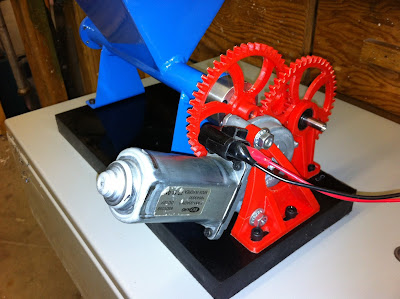I originally posted this on the madmodder buletin board a few years ago after I discovered how well this design worked for me. (Original Post) I wanted to share it with other HSM's as an affordable and easy approach to making an internal threading tool. Some criticism was received about clearance angles, and the heat treating, but many who have invested the time to make it were pleasantly surprised with the quality of threads they were able to produce. Anyways, I'm bringing the original post to my own blog to live for eternity...
Here's the start of the original thread:
So, yeah, I dont know if this is a new thing or not, but I've never seen another tutorial for making this type of tool anywhere so far, so here goes.
I will show you a simple way to make a threading tool completely on your lathe that can do both external as well as internal threads. I have many pictures of the process, and there's a .pdf of the actual tool with all the critical dimensions that you can download.
First off, i looked for quite some time at buying an internal threading tool that uses inserts, but the cost was rather prohibitive. Not to mention that they tell you that you need different inserts for different pitch ranges. BS I say. I'm not spending hundreds on pro tool holders and inserts. I don't need to do production threading, so I can't justify the purchase. So I came up with this idea. A machinist friend told me that it would undoubtly not work since the design lacks some clearance angles. Being a bit hard headed, I made one anyways. That was 2 years ago, and that original threading tool just failed last week, hence this article. (my bad, broke the tip off not stopping soon enough...)
The steel bar used for this is called drill rod here in Canada. It can be purchased almost anywhere. Bolt supply stores will have it, and steel dealers will know of it. It's sold in 3' lengths here. I'm not sure of the exact composition, but it's similar to O1 tool steel, I'm told. Anyways, it's stringy to work on the lathe, and not the nicest stuff for other processes, but when it's done and hardened, it's a great tool material.
Step 1, get some drill rod that matches your boring tool holder diameter. Here I'm using 5/8". (the drawing shows 1/2", but use any size you want...) Square a T style insert to the workpiece. The edges of this tool will form the v in your threads, so take your time making sure it's good n square.
Step 2, layout the shoulder line. You don't really need to do this, make it as long as you want.
Step 3, turn the OD down to whatever you want to start with. I used 1/2" because this tool will be used on large internal threads, 2 inch and over. The smaller you make the tool, the smaller the internal threads you can make.
Step 4, Turn the undercut shaft. Keep this as short as possible, just like short stout borring tools, this follows the same idea.
Step 5, Make the point. Use the side of the insert to make the sides nice and flat.
Step 6, Part it off.
So that's it for the turning. You should break all the sharp edges here, and face the ends of the tool flat if they aren't already.
On to the milling. This is the first time that I've done the milling part in the lathe, but it worked OK so I will show you what I did here. Normally, I would set up the mill, clamp the tool in a vise and mill away the material, but this worked OK. Make sure everything is tight, I had some vibration when I was doing this, and the toolholder actually turned, which is not cool to see when you are hogging off material.
So, put your 1/2 finished tool in your boring tool holder. Make sure it's clamped down tight.
I used a 1/2" 4FL endmill for this, but you can use whatever you have laying around.
I adjusted the height of the threading tool to be cut manually. I started high and took a few light cuts, then just kept lowering the tool by hand, making sure the QC tool post wedged in hard each time, at each height. You can work this anyway you want. It didn't take but a few minutes and I had all the material I wanted removed.
Not the nicest machining but hey, it worked ,especially if you only have a lathe.
So that concludes the machining, that took you about 15 minutes right?
Now the hard part, or should I say the hardeneing part? Regardless, it really easy with this steel. Heat to glowing orange, quench in water. Done. Check by trying to file. If you CAN file it's not hard, do the steps again. If the file bounces off, Good job!
Step 1, get a can full of water, a propane torch, and hold your tool with some visegrips as shown here:
(Pistachio cans make the tool harder, that's why i use them)
Step 2, fire up the torch to high and get the tip of the tool bright orange.
Step 3, be quick as you quench the entire tool and the visegrips and your hand in the can of water, try to cool the piece as fast as cosmicly possible. This will give the best chance of making the tool hard.
Step 4, try to file part of your now hard tool. Do this on an edge that isn't important, because if you didn't get it hard, you don't want to screw up one of the critical edges right?
If the tool is adequately hard the file will not do anything. Stop now or risk destroying your file. (you should use an old file anyways...)
So if it's hard, all you have left to do is hone the top face of the tool. This is the only surface you sharpen, never try to hone the sides or you will change the angle.
(Note: There was great discussion about this on the original post, and I agree with the comment that at this point, the tool should be tempered back from full hard to ensure toughness as well as hardness. When I made these tools for threading aluminum, it didn't seem necessary, but proper form would be to temper. To do this, polish the tool so that it's bright, you need to do this to be able to see the tempering color. Now very carefully heat the cutting end of the tool. What you are looking for is for the color of the cutting tip to turn straw yellow, this is the first color that it will start turning when heated. Here's the trick, just before it turns yellow, stop heating. If it looks like you got it too hot and it's going through the colors, quench it to stop. I will do a better write up of this procedure someday.)
Just setup the tool in your boring tool holder and thread away!
Comments are always welcome!
Here's a link to the drawing of the tool. Adjust to suit your needs!
BD-LatheTools.pdf
Paul

























